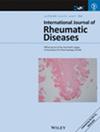Case Series: Extracutaneous Findings of Eosinophilic Fasciitis Patients
Abstract
Objective
Eosinophilic fasciitis (EF) is a connective tissue disorder characterized by cutaneous changes similar to scleroderma, usually associated with peripheral eosinophilia. This case series highlights clinical findings, particularly extracutaneous involvement, in EF patients to enhance clinician awareness of this rare condition.
Methods
EF patients' skin and visceral organ involvement, musculoskeletal findings, laboratory tests (including acute phase reactants, autoantibodies, protein electrophoresis, etc.), magnetic resonance imaging (MRI), skin biopsy results, and treatments were evaluated.
Results
The patient's age at presentation was 54 (range 23–68), and 50% were female. All patients presented with skin thickening in the distal upper extremities, except for the hands and feet. Notably, 50% of the patients showed involvement in the trunk, while 87.5% exhibited involvement in the distal lower extremities. A total of 87.5% of patients had increased acute-phase reactants, and three-quarters had peripheral eosinophilia. Some patients presented with extracutaneous manifestations such as nonspecific pulmonary nodules, neuropathy, or arthritis. MRI scans on all patients revealed notable thickening, contrast enhancement, and increased signal intensity within the fascia. Treatment involved the initiation of corticosteroids, with 87.5% of patients requiring the addition of an immunosuppressive agent due to an inadequate response. While no hematological malignancies were detected during the follow-up period, solid cancer was detected in one patient.
Conclusion
Patients diagnosed with EF should undergo a thorough evaluation for extracutaneous involvement, including joints, lungs, and muscles, as well as screening for occult malignancies. In instances where the condition does not respond to steroid therapy, it may be necessary to consider additional immunosuppressive treatments.

 求助内容:
求助内容: 应助结果提醒方式:
应助结果提醒方式:


